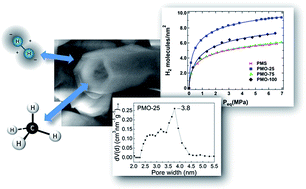Enhanced hydrogen and methane storage of hybrid mesoporous organosilicas†
Abstract
In this study, hybrid mesoporous organosilicas (HMOs) were synthesized by using tetraethyl orthosilicate (TEOS) as the silica source and 1,4-bis(triethoxysilyl)benzene (BTB) in various ratios of BTB to TEOS. The two extreme cases of 0 and 100 mol% BTB were compared with the partial addition of BTB (25 mol%) and the partial absence of TEOS (75 mol% BTB). The synthesized mesoporous materials were characterized by means of powder X-ray diffraction (PXD), scanning electron microscopy (SEM) and helium pycnometry for the determination of skeletal density. The Brunauer–Emmett–Teller (BET) method was used for the determination of the specific surface area (SSA) and non-local density functional theory (NLDFT) calculations were employed for the determination of the pore size distribution (PSD). The hydrogen and methane sorption properties were investigated using a Sieverts apparatus under isothermal sorption equilibrium conditions at cryogenic and close to ambient temperatures, respectively. For hydrogen, the combination of phenyl rings with pores at the micro/mesopore border resulted in an increase in sorption capacity. The simultaneous presence of two different precursors increased the surface inhomogeneity, which led to a wider distribution of adsorption sites close to the micro/mesopore border, which favored the hydrogen sorption properties. The presence of the phenyl rings doubled the number of methane molecules that the material surface could accommodate. The partial substitution of TEOS by BTB (25 mol%) gave the same density of adsorbed methane as the non-hybrid material, which consisted of 100% BTB. The materials exhibited excellent reversibility and sorption stability upon aging. Their sorption performance was evaluated using the Tóth model and was correlated with their structural characteristics. The fraction of micropores among the total number of pores was quantitatively correlated with the maximum storage capacity and the adsorbate–adsorbent interaction strength. Finally, for a low coverage of methane the enthalpy of adsorption was calculated by the Clausius–Clapeyron equation.



 Please wait while we load your content...
Please wait while we load your content...